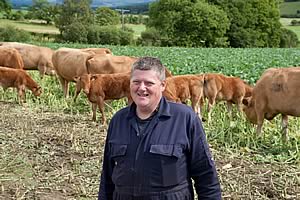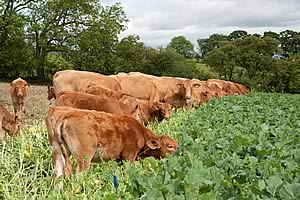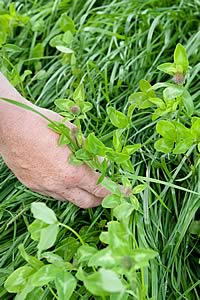 |
|||||||||
|
|||||||||||||||||||
|
|
Alternative Crops Maximise Forage Acreage on Upland Farm Upland farmer Richard Barron is maximising his forage acreage on land running at up to 1,000ft above sea level in Northumberland with brassicas and specialist grazing leys.
Richard and his wife Jean purchased White Hall, Whitley Chapel, near Hexham in 2001 to run alongside their 89 acre tenanted unit Deans Farm at Edmundbyers, near Consett in Co Durham. White Hall had been run by Richard’s parents Ken and Eleanor and the opportunity arose to purchase it from the county council. Now joined in the business by their 19 year old son Shaun, who is studying for an honours degree in rural enterprise and land management at Harper Adams University College, Shropshire, the Barrons have been building up a pedigree South Devon beef herd as part of their 90-cow suckler enterprise and are now looking closely at the cost of feed inputs. White Hall’s 260 acres, which has no cropping land and includes some fell and rough grazing, runs from 700ft to over 1,000ft above sea level. South Devon cattle were chosen for their docility, ease of management and ability to feed off forage after the Barrons’ experiences with bought-in Blonde cross South Devon heifers. Now the Fellview pedigree herd numbers half the cows and the first pedigree heifers were sold this spring in Carlisle. “I am wintering the cows very cheaply - my grass silage worked out at £8 a bale to make myself and last year the cost was just £85 a cow to winter on silage,” said Richard. “While Shaun was studying for his National Diploma in Agriculture at Newton Rigg, Penrith, he did a project on forage crops and he was keen for us to experiment. I have also been listening to advice from EBLEX on alternative forage crops.”
A further 13 acres of hay are made on Higher Level Stewardship ground at White Hall for the 200-ewe flock of Swaledales, 80 of which are bred pure for replacements and the remainder crossed with the Bluefaced Leicester for Mule production. Another 30 acres of silage is made at Deans Farm in the first week in July. After spreading the ground with FYM, the six acres was ploughed by a contractor and worked before Richard broadcast the seed in mid-May with his quad bike seed sower and, despite several weeks without rain, the crop established well. Cows were initially strip grazed on the Redstart area, with the fence being moved 4 metres a day across the 100 metre wide field. They also have access to straw in a ring feeder for fibre, and silage aftermath is also available for grazing. “The cows are cleaning the crop right off, going back to crunch the stalks after eating the leaves,” said Richard. “The calves are also eating it and growing well on it. The cows are producing a lot of milk as it’s very high in protein.” Last year Swift was grown on six acres as a late crop for grazing, running the cattle inside at night, however, six weeks of deep snow at White Hall made full-time housing of the cattle inevitable. “The crop was late and not intended as a winter crop but it was not a complete failure as we grazed it with the ewes crossed with the Bluefaced Leicester and – supplemented with sugar beet pulp and three bales of haylage - it lasted six weeks,” said Richard. “We had a good lambing from the ewes.”
“It has come on well despite the dry spring and we expect to take two cuts of silage,” said Richard. “We shall then finish the Swaledale and Mule wether lambs on in through to February with three-quarters finishing off grass and sold through Hexham Mart. “I’m hoping the clover rich big bales will help to cut the winter feed bill for the youngstock. Last winter we used 15 tonnes of rape meal and distillers’ grains at nearly £200 a tonne so having the quality big bales should halve the feed bill. The grassland was due for re-seeding, so was a cost we were scheduled to incur.” Another 12 acres of former heather-covered ground at 1,000ft, last re-seeded 19 years ago with a cocksfoot type ley and now worn-out, is being re-seeded for the autumn with a permanent pasture mix including another alternative forage Puna II perennial chicory. The brassica crop has freed-up enough ground to enable this improvement for grazing and possibly silage ground.
|
||||||||||||||||||

|
|
||||||||||||||||||
| home | agri-services | pedigree
pen | news | dairy | beef | machinery property | organisations | site map |
|||||||||||||||||||

Article by
Jennifer MacKenzie


